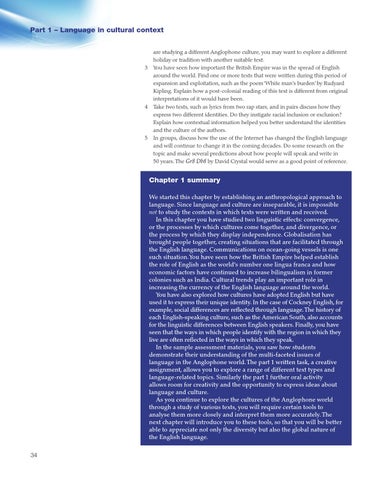Part 1 – Language in cultural context are studying a different Anglophone culture, you may want to explore a different holiday or tradition with another suitable text. 3 You have seen how important the British Empire was in the spread of English around the world. Find one or more texts that were written during this period of expansion and exploitation, such as the poem ‘White man’s burden’ by Rudyard Kipling. Explain how a post-colonial reading of this text is different from original interpretations of it would have been. 4 Take two texts, such as lyrics from two rap stars, and in pairs discuss how they express two different identities. Do they instigate racial inclusion or exclusion? Explain how contextual information helped you better understand the identities and the culture of the authors. 5 In groups, discuss how the use of the Internet has changed the English language and will continue to change it in the coming decades. Do some research on the topic and make several predictions about how people will speak and write in 50 years. The Gr8 Db8 by David Crystal would serve as a good point of reference.
Chapter 1 summary We started this chapter by establishing an anthropological approach to language. Since language and culture are inseparable, it is impossible not to study the contexts in which texts were written and received. In this chapter you have studied two linguistic effects: convergence, or the processes by which cultures come together, and divergence, or the process by which they display independence. Globalisation has brought people together, creating situations that are facilitated through the English language. Communications on ocean-going vessels is one such situation. You have seen how the British Empire helped establish the role of English as the world’s number one lingua franca and how economic factors have continued to increase bilingualism in former colonies such as India. Cultural trends play an important role in increasing the currency of the English language around the world. You have also explored how cultures have adopted English but have used it to express their unique identity. In the case of Cockney English, for example, social differences are reflected through language. The history of each English-speaking culture, such as the American South, also accounts for the linguistic differences between English speakers. Finally, you have seen that the ways in which people identify with the region in which they live are often reflected in the ways in which they speak. In the sample assessment materials, you saw how students demonstrate their understanding of the multi-faceted issues of language in the Anglophone world. The part 1 written task, a creative assignment, allows you to explore a range of different text types and language-related topics. Similarly the part 1 further oral activity allows room for creativity and the opportunity to express ideas about language and culture. As you continue to explore the cultures of the Anglophone world through a study of various texts, you will require certain tools to analyse them more closely and interpret them more accurately. The next chapter will introduce you to these tools, so that you will be better able to appreciate not only the diversity but also the global nature of the English language. 34
